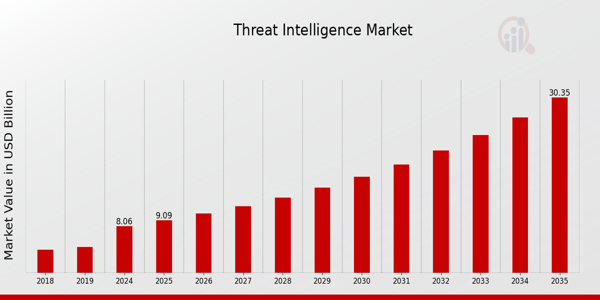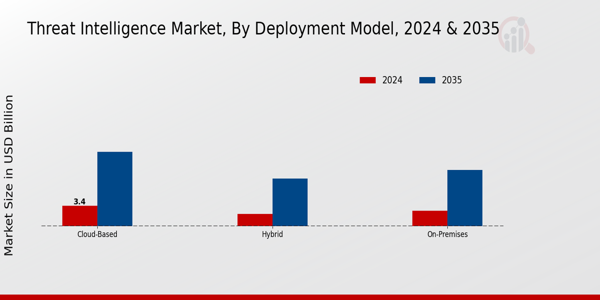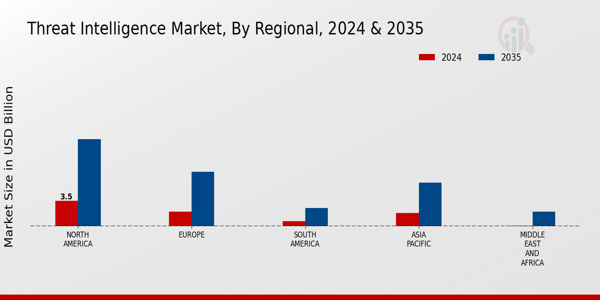Threat Intelligence Market Summary
As per Market Research Future Analysis, the Threat Intelligence Market is experiencing significant growth driven by rising cybersecurity threats and evolving regulatory compliance. The market was valued at 8.06 USD Billion in 2024 and is projected to reach 30 USD Billion by 2035, with a CAGR of 11.58% from 2025 to 2035. Key sectors such as BFSI, Government, and Healthcare are increasingly investing in threat intelligence solutions to safeguard sensitive data against cyber threats. The market is characterized by a shift towards cloud-based deployment models and the integration of AI and ML technologies to enhance threat detection and response capabilities.
Key Market Trends & Highlights
The Threat Intelligence Market is witnessing transformative trends driven by technological advancements and increasing cyber threats.
- Market Size in 2024: 8.06 USD Billion; Expected to grow to 30 USD Billion by 2035.
- CAGR from 2025 to 2035: 11.58%; indicating robust growth.
- Cloud-Based deployment model projected to reach 12.0 USD Billion by 2035.
- Cybercrimes expected to cost the global economy approximately 10.5 trillion USD annually by 2025.
Market Size & Forecast
2024 Market Size: USD 8.06 Billion
2035 Market Size: USD 30 Billion
CAGR (2025-2035): 11.58%
Largest Regional Market Share in 2024: North America
Major Players
Bae Systems, IBM, FireEye, CrowdStrike, Palo Alto Networks, Fortinet, ThreatConnect, Recorded Future, RedSeal, Digital Shadows, Cisco, Trend Micro, Check Point Software, ThreatQuotient, McAfee
Key Threat Intelligence Market Trends Highlighted
The Threat Intelligence Market is expanding rapidly, driven by an increase in cyber threats and the sophistication of assaults on enterprises. With the development of the internet and linked devices, fraudsters are discovering new routes of exploitation, prompting businesses to invest in threat intelligence solutions to improve cybersecurity defenses. Compliance with government data protection rules is also a significant market driver, prompting firms to use advanced threat intelligence to satisfy legal criteria and preserve sensitive information. The opportunities in this field are enormous, especially for organizations that can provide real-time threat monitoring and predictive capabilities.
As organizations grasp the value of proactive cybersecurity, there is a growing need for integrated solutions that can give actionable insight rapidly. Furthermore, enterprises are increasingly partnering with third-party suppliers and intelligence-sharing platforms to improve their cybersecurity posture, pointing to a growing trend of global collective cybersecurity initiatives. In recent years, the market has experienced a trend toward automation and artificial intelligence. Companies are using AI technology to handle and analyze massive volumes of data in order to detect and respond to emerging dangers.
Cloud-based threat intelligence solutions have also grown in popularity, allowing enterprises of all sizes to have access to these capabilities without making major upfront infrastructure costs. Overall, the global threat intelligence picture is always changing, impacted by technology breakthroughs and a growing awareness of the importance of comprehensive cybersecurity systems.

Source: Primary Research, Secondary Research, Market Research Future Database and Analyst Review
Threat Intelligence Market Drivers
Increasing Cybersecurity Breaches
The Threat Intelligence Market Industry is significantly driven by the increasing frequency and severity of cybersecurity breaches worldwide. Recent data indicates that there has been a 50% increase in reported cyber incidents over the past three years, as reported by cybersecurity entities focusing on global data breaches.
Organizations like the Cybersecurity and Infrastructure Security Agency (CISA) in the United States have noted that cyberattacks are becoming more complex and impactful, causing organizations to lose large amounts of sensitive data and financial resources.The rise in data breaches has led governments around the world to strengthen their regulations concerning data protection, thus prompting companies to invest in advanced threat intelligence solutions. The expansion of regulations such as the General Data Protection Regulation (GDPR) in Europe drives the demand for comprehensive threat intelligence services to ensure compliance and protect sensitive information.
Hence, the growth in cybersecurity threats is catalyzing the adoption of threat intelligence services on a global scale.
Adoption of Cloud-based Solutions
The shift towards cloud computing is another crucial driver for the Threat Intelligence Market Industry. With an increasing number of enterprises transitioning their operations to the cloud, there is a heightened need for robust threat detection and response mechanisms. Reports suggest that over 80% of businesses globally are utilizing cloud services, and this trend is expected to continue.
Organizations like Microsoft and Amazon Web Services are continually enhancing their cloud security frameworks, creating a substantial market for threat intelligence solutions that can seamlessly integrate into these platforms.As businesses migrate to cloud environments, the demand for advanced threat intelligence that can operate within these infrastructures is rising significantly, thus propelling market growth in the coming years.
The Growing Need for Regulatory Compliance
With increasing regulatory requirements globally, organizations are compelled to implement effective threat intelligence solutions to ensure compliance. Regions such as the European Union have adopted stringent regulations related to cybersecurity, making it necessary for companies to bolster their cybersecurity measures. A report from the European Union Agency for Cybersecurity (ENISA) highlighted that nearly 60% of companies faced compliance audits in the last year.The need to meet these regulatory demands leads organizations to invest significantly in threat intelligence services that help them identify, analyze, and mitigate potential threats effectively.
Thus, regulatory compliance acts as a crucial growth factor for the Threat Intelligence Market Industry.
Threat Intelligence Market Segment Insights
Threat Intelligence Market Deployment Model Insights
The Threat Intelligence Market is experiencing notable growth within the Deployment Model segment, projected to reach a value of 8.06 USD Billion in 2024, with significant expansion expected as it evolves through to 2035, where it could potentially hit 30.0 USD Billion. Among the various deployment models, Cloud-Based solutions are becoming increasingly significant, holding a value of 3.4 USD Billion in 2024 and projected to grow to 12.5 USD Billion by 2035.
This model dominates the market due to its flexibility, scalability, and cost-effectiveness, making it a preferred choice for numerous organizations looking to enhance their security posture efficiently.The On-Premises model follows with a valuation of 2.6 USD Billion in 2024, anticipated to reach 9.5 USD Billion in 2035, catering to businesses that prioritize greater control and security of their data. While this model provides robustness in security and compliance, it often comes with higher operational costs.
Meanwhile, the Hybrid deployment model, valued at 2.06 USD Billion in 2024 and projected at 8.0 USD Billion by 2035, allows organizations to leverage the benefits of both cloud and on-premises solutions, providing a level of flexibility and adaptation that resonates well with evolving business needs.The increasing incidence of security breaches globally is driving the demand for effective threat intelligence solutions, with many organizations viewing these deployment models as critical in addressing their security challenges.
The rise in cyber threats, along with the growing focus on proactive security measures, underscores the importance and relevance of cloud-based and hybrid models, as they capture the majority of the market. Overall, the deployment models in the Threat Intelligence Market are shaping the industry's direction, as organizations increasingly seek solutions that provide agility and comprehensive threat insights amidst a changing digital landscape.

Source: Primary Research, Secondary Research, Market Research Future Database and Analyst Review
Threat Intelligence Market Component Insights
The Threat Intelligence Market, focusing on the Component segment, is witnessing considerable growth as organizations prioritize cybersecurity investments. In 2024, the market is expected to be valued at 8.06 billion USD, showcasing its importance in safeguarding digital infrastructures. The Components segment encompasses various offerings, with Solutions, Services, and Platforms being critical aspects. Solutions, designed to detect and respond to cyber threats, are vital for ensuring immediate protection. Services, including consulting and managed security, provide expertise that enhances organizational resilience against threats.Platforms facilitate the integration and management of threat intelligence, making them essential for efficient data analysis and decision-making.
The increasing number of cyber attacks and the consequent demand for advanced defense mechanisms significantly drive market growth. Furthermore, regulatory frameworks and compliance requirements across the globe push businesses to adopt robust threat intelligence measures. As organizations worldwide recognize the importance of predictive analytics and proactive threat management, the Threat Intelligence Market segmentation highlights a diversified landscape that is evolving rapidly to meet contemporary security challenges.
Threat Intelligence Market Application Insights
The Threat Intelligence Market for the Application segment is poised for substantial growth, with a market valuation expected to reach 8.06 USD Billion in 2024 and projected to expand to 30.0 USD Billion by 2035. This significant increase highlights the importance of threat intelligence solutions in safeguarding digital assets across various applications. Within this segment, solutions related to Network Security and Endpoint Security play critical roles in protecting an organization's information systems from unauthorized access and cyber threats.Similarly, Cloud Security has gained prominence as businesses increasingly migrate their data and applications to cloud environments, necessitating robust protection against evolving threats.
Application Security is also crucial as it focuses on securing individual applications from vulnerabilities, ensuring that software applications are reliable and safe for end-users. The Threat Intelligence Market data shows a strong demand for these solutions as organizations recognize the importance of proactive measures against cyber risks. The anticipated market growth can be attributed to the rising frequency of cyberattacks and the need for enhanced security measures across all sectors globally.Challenges remain, including the complexity of integrating these solutions into existing infrastructures, but the ongoing digital transformation offers ample opportunities for innovation and market expansion.
Threat Intelligence Market End Use Insights
The Threat Intelligence Market is poised for robust growth, particularly across diverse end-use sectors such as BFSI, Government, Healthcare, IT and Telecom, and Retail. In 2024, the overall market is forecasted to be valued at 8.06 Billion USD, reflecting a strong upward trend driven by increasing cyber threats and data breaches. The BFSI sector is substantial due to its critical need for securing sensitive financial information, making it a leader in adopting threat intelligence solutions.
Governments globally are investing significantly in cyber defense, thus enhancing their IT infrastructures to safeguard national security.In the Healthcare vertical, the rising incidents of patient data theft highlight the necessity for advanced threat intelligence. The IT and Telecom industries prioritize protecting extensive networks and customer data, thus regard threat intelligence as essential for operational integrity. Retail also holds a noteworthy position as e-commerce platforms become prime targets for cybercriminals. Overall, the Threat Intelligence Market segmentation underscores the pivotal role these sectors play in propelling market growth, while ongoing digital transformation presents both challenges and opportunities for enhanced cybersecurity implementations.
Threat Intelligence Market Regional Insights
The Threat Intelligence Market demonstrates robust growth across various regions, with the overall market expected to reach 8.06 USD Billion in 2024 and projected to grow to 30.0 USD Billion by 2035. North America emerges as a dominant player with a noteworthy valuation of 3.5 USD Billion in 2024, escalating to 12.0 USD Billion by 2035, driven by advanced technological infrastructures and heightened cybersecurity concerns.
Europe follows suit, holding a significant market value of 2.0 USD Billion in 2024, expected to reach 7.5 USD Billion by 2035, reflecting increasing regulatory compliance demands and investments in cybersecurity.The Asia Pacific region, valued at 1.8 USD Billion in 2024 and expected to grow to 6.0 USD Billion by 2035, is gaining traction due to rapid digital transformation and the emergence of cyber threats. Meanwhile, South America, with a value of 0.7 USD Billion in 2024 and anticipated growth to 2.5 USD Billion by 2035, is gradually establishing its footprint as organizations recognize the importance of threat intelligence.
The Middle East and Africa, while currently valued at 0.06 USD Billion in 2024, shows potential for significant growth, expanding to 2.0 USD Billion by 2035, as governments take steps to enhance their cybersecurity postures.The combined dynamics across these regions signal a clear emphasis on developing comprehensive threat intelligence strategies to counteract emerging cyber risks.

Source: Primary Research, Secondary Research, Market Research Future Database and Analyst Review
Threat Intelligence Market Key Players and Competitive Insights
The Threat Intelligence Market has been experiencing substantial growth, driven by the rising number of cyber threats and the increasing awareness among organizations about the necessity for robust cybersecurity measures. This market includes a variety of services, tools, and solutions aimed at identifying, analyzing, and mitigating potential threats to an organization’s information systems.
Competition within this sector remains fierce, as many players strive to enhance their offerings through innovation and strategic partnerships. Key trends in the market involve the integration of artificial intelligence and machine learning to enhance threat detection capabilities. In addition, the expansion of digital transformation across industries is increasing the demand for threat intelligence services, resulting in a dynamic landscape characterized by rapid technological advancements and evolving competitive strategies.Check Point Software Technologies has established itself as an influential player in the Threat Intelligence Market.
Its primary strengths lie in its comprehensive cybersecurity solutions that integrate threat intelligence to protect businesses from advanced cyber threats. The company's approach combines static and dynamic threat prevention technologies, making its offerings particularly effective against evolving and sophisticated attacks.
With a broad global presence, Check Point’s innovative cybersecurity solutions are widely adopted across various industries. The company consistently invests in research and development, allowing it to stay ahead of the curve in threat detection and response. This commitment to innovation, combined with its extensive history and expertise, enables Check Point to maintain a strong competitive edge in the marketplace.McAfee operates prominently within the Threat Intelligence Market by offering a suite of products and services designed to safeguard organizations against cyber threats.
The company’s core strengths include its robust security architecture and a vast network of threat intelligence resources that provide real-time insights into emerging threats. McAfee’s presence in the market is bolstered by its focus on cloud security, endpoint protection, and data protection solutions, which are essential for organizations undergoing digital transformation.
The company has engaged in strategic mergers and acquisitions to expand its capabilities and market reach, further enhancing its value proposition. As part of its growth strategy, McAfee continues to refine its product offerings, ensuring they align with the evolving needs of businesses globally. This adaptability, coupled with a strong reputation for effective cybersecurity solutions, positions McAfee as a formidable competitor in the Threat Intelligence Market.
Key Companies in the Threat Intelligence Market Include
- Check Point Software Technologies
- McAfee
- ThreatConnect
- CrowdStrike
- Palo Alto Networks
- AlienVault
- IBM
- RiskIQ
- Recorded Future
- Forcepoint
- Cisco Systems
- DigitalGuardian
- Mandiant
- FireEye
Threat Intelligence Market Industry Developments
Recent developments in the Threat Intelligence Market show a significant emphasis on proactive cybersecurity. Companies such as Check Point, McAfee, and CrowdStrike are constantly improving their intelligence systems to meet increasing demand. Microsoft purchased RiskIQ in July 2021, bolstering its threat surface management portfolio. Palo Alto Networks announced enhanced AI-infused threat intelligence and prevention products (Precision AI, AI-SPM, and AI Runtime Security) in May 2024.
Meanwhile, DigitalGuardian and FireEye/Mandiant have made incremental improvements to their capabilities, enabling complete detection and response. McAfee and IBM remain significant participants, backed by agreements and enhancements to their intelligence suites. The market is expected to develop at a 20%+ CAGR through 2025, driven by persistent cyber threats and increased organizational dependence on threat intelligence.
Threat Intelligence Market Segmentation Insights
-
Threat Intelligence Market Deployment Model Outlook
- Cloud-Based
- On-Premises
- Hybrid
-
Threat Intelligence Market Component Outlook
- Solutions
- Services
- Platform
-
Threat Intelligence Market Application Outlook
- Network Security
- Endpoint Security
- Cloud Security
- Application Security
-
Threat Intelligence Market End Use Outlook
- BFSI
- Government
- Healthcare
- IT and Telecom
- Retail
-
Threat Intelligence Market Regional Outlook
- North America
- Europe
- South America
- Asia Pacific
- Middle East and Africa
|
Report Attribute/Metric
|
Details
|
|
Market Size 2023
|
7.22(USD Billion)
|
|
Market Size 2024
|
8.06(USD Billion)
|
|
Market Size 2035
|
30.0(USD Billion)
|
|
Compound Annual Growth Rate (CAGR)
|
12.81% (2025 - 2035)
|
|
Report Coverage
|
Revenue Forecast, Competitive Landscape, Growth Factors, and Trends
|
|
Base Year
|
2024
|
|
Market Forecast Period
|
2025 - 2035
|
|
Historical Data
|
2019 - 2024
|
|
Market Forecast Units
|
USD Billion
|
|
Key Companies Profiled
|
Check Point Software Technologies, McAfee, ThreatConnect, CrowdStrike, Palo Alto Networks, AlienVault, IBM, RiskIQ, Recorded Future, Forcepoint, Cisco Systems, DigitalGuardian, Mandiant, FireEye
|
|
Segments Covered
|
Deployment Model, Component, Application, End Use, Regional
|
|
Key Market Opportunities
|
Increasing regulatory compliance demands, Rising adoption of AI technologies, Enhanced cybersecurity awareness, Growth in IoT security solutions, Integration of threat intelligence platforms
|
|
Key Market Dynamics
|
growing cyber threats, increasing regulatory compliance, demand for real-time data, integration of AI technologies, and rising cloud adoption
|
|
Countries Covered
|
North America, Europe, APAC, South America, MEA
|
Threat Intelligence Market Highlights:
Frequently Asked Questions (FAQ):
By 2035, the Threat Intelligence Market is expected to be valued at 30.0 USD Billion.
The projected CAGR for the Threat Intelligence Market from 2025 to 2035 is 12.81%.
In 2024, North America holds the largest market share with a valuation of 3.5 USD Billion.
The Asia Pacific region is expected to contribute 6.0 USD Billion to the Threat Intelligence Market by 2035.
Key players in the Threat Intelligence Market include Check Point Software Technologies, McAfee, CrowdStrike, and IBM, among others.
The market size for cloud-based deployment of threat intelligence is anticipated to reach 12.5 USD Billion by 2035.
The on-premises segment is expected to grow to 9.5 USD Billion by 2035, indicating significant growth potential.
The hybrid deployment model is expected to reach a market size of 8.0 USD Billion by 2035.
Challenges such as evolving cyber threats and increasing compliance demands are impacting the growth of the Threat Intelligence Market.
Europe is anticipated to reach a market size of 7.5 USD Billion in the Threat Intelligence Market by 2035.

















